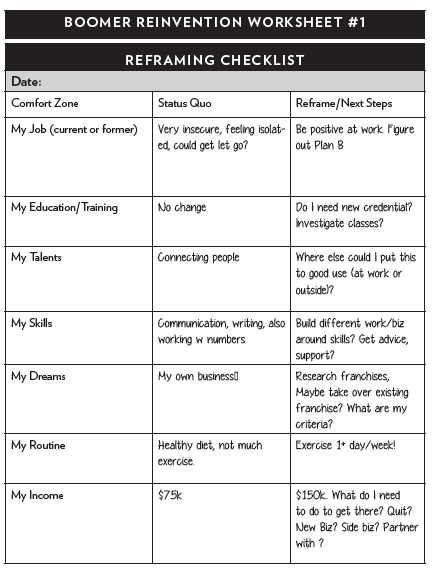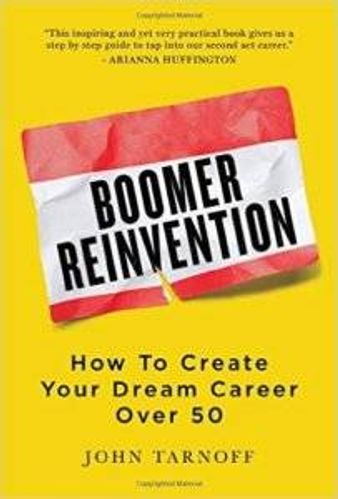Reframe Yourself to Create Your Dream Career After 50
5 strategies from the new book, 'Boomer Reinvention'
(This article is excerpted from Boomer Reinvention: How to Create Your Dream Career Over 50 by John Tarnoff © Copyright Reinvention Group LLC)
Many of us in our 50s are angry — justifiably — that in many cases, our careers are being cut short while we are still more than competent, more than capable and arguably at the top of our game. While there are certainly external factors standing in our way, we also have to acknowledge that part of the problem is our own unwillingness to change and adapt to the world around us. Career reinvention is really an imperative.
Reinvention is not about trying to figure out what job or business you can fit into. It’s about figuring out what job or business is already inside you. Reinventing your career means shifting your mindset as well as your job description. This book, Boomer Reinvention, and my Boomerreinvention website can help. (The site has all the worksheets in the book including the one below.)
We boomers are not the same people we were in our 20s. Isn’t it time to reframe our beliefs about who we are and what we can do and leverage the wisdom and experience we’ve acquired?
We all carry judgments and beliefs that we don’t question, but which may be outdated. Reframing is the process that calls those outdated realities into question and tries to come up with alternative perceptions that may be more accurate and more supportive for us than the old ways we’ve been holding onto.
Successful reframing of our views and beliefs frees us to see the world and ourselves in a different light. Unshackled from the beliefs that may have been putting limits on our abilities because of fears, not facts, we may now be in a position to entertain new ways of living, working and relating to our family friends and colleagues.
Here are five strategies to shift your perspective (which is built on your past) and shift it into your present.
Strategy No. 1: Assess the Status Quo
See the accompanying Worksheet #1: Reframing Checklist as an example of how to do this. You can make your own Reframing Checklist by creating a blank worksheet and filling in your Comfort Zone thoughts or perceptions for your job, education, talents, etc. and in the Reframe/Next Steps column indicating the changes you need to make, or would like to make, to pull you beyond your comfort zone and be more proactive.

Strategy No. 2: Reframe the Personal and the Local
The next step is dealing with the ingrained beliefs you have about how the world works and ideas and experiences you’ve accumulated but that may be outdated.
Here, list up to five experiences that each had a disappointment, defeat and an obstacle and then reframe those by listing a lesson, opportunity and insight you gained from each.
Shifting to an updated perspective may effectively close the book on conflicts and bad feelings you’ve been harboring and may trigger additional thoughts.
Strategy No. 3: Reframe Limiting Roles — Or: You Are More Than Your Resume
Here, reframe the roles you’ve played personally and professionally in your life. This is particularly helpful if you’ve been, say, employed in a certain job or role for many years.
Rather than look at yourself as a job description or a set of tasks, think about yourself in terms of the impact you have (or have had) as a person in that role, creating lasting effect and value. Write down thumbnail job descriptions you’ve had and then reframe them into active, results-oriented impact descriptions.
Here’s an example:
Current Role: VP Sales. Description: Responsible for supervising sales team in Western Region and customer relationships
Reframed Role: CMO. Impact Description: Building a collaborative team around company goals, improving client relations, developing new business lines w. sr. mgmt. colleagues
As you reframe your roles, look for aspects, skillsets and responsibilities that could be applicable in other fields.

Strategy No. 4: Tease Your Comfort Zone — Act ‘As If’
Now that you’ve got some experience thinking differently, try acting a little differently. The “acting as-if” behavioral tool helps people step into new ways of behaving and try out prospective habits and mindsets.
For example: You may never have owned a business, but what would it feel like to act as if you owned one? Do you think it might put some spring in your step? Or if you can’t stand your boss, try going to work acting and feeling as though you got along beautifully.
By stepping into the fantasy, you have an incentive to step forward and perhaps accelerate changing what you need to change to make it happen.
You could get out of your comfort zone by, for example, subscribing to a few magazines or online newsletters covering subject matter you might not be familiar with. Or cultivate friends at least 10 years younger than you are.
Strategy No. 5: Reframe your Mission
We’re used to thinking about mission statements as motivational mottos for companies — describing the meaning, purpose, goals and values of an organization. What would a new mission statement look like for you to describe the way you want to see yourself going forward?
Your new mission statement should distinguish you from how you have lived until now. Include the work-life balance you are trying to achieve or be specific about the career focus you’re looking for. Your mission statement should inspire you to keep pursuing your reinvention journey. Share it with trusted family and friends to see how it resonates with them and for feedback on making it more specific and more reflective of your mission.
Reframing doesn’t mean you have to know the solution to your problem or what your reinvented career is going to look like. There’s plenty of room ahead to figure that out.
Just start finding the niche that best represents your usefulness to the world at large and go for it.


